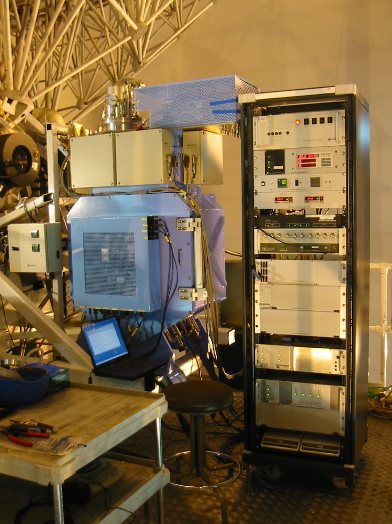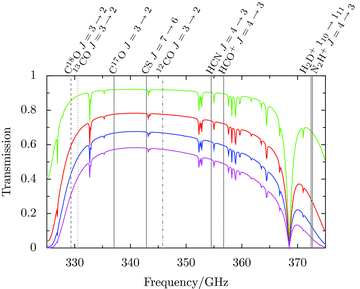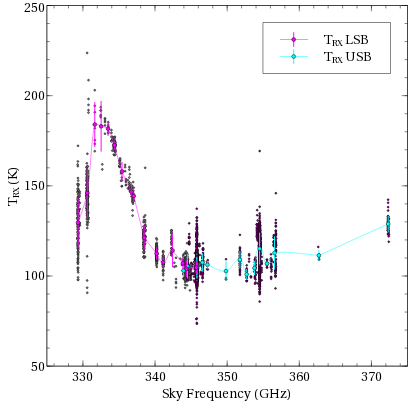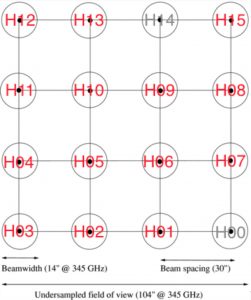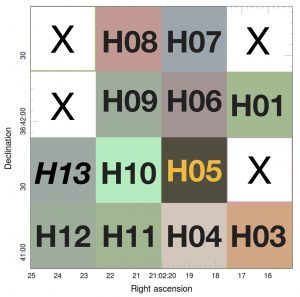HARP (Heterodyne Array Receiver Program) is a Single Sideband (SSB) array receiver with 16 SIS mixers. HARP can be tuned between 325 and 375 GHz and has a instantaneous bandwidth of ~2 GHz and an Intermediate Frequency (IF) of 5 GHz. The unwanted sideband is terminated on a 20 K load inside the Dewar. The mixers are called receptors and arranged in a 4×4 configuration. The different receptors are separated by 30″ and named H00, H01 … H15. HARP was designed and built by University of Cambridge in collaboration with different other groups.
The half power beam width of each receptor is approximately 14 arcsec. One of the four center receptors is used for pointing and focus observations and for pointed observations. This is called the tracking receptor, currently it is H05.
At 345GHz the main beam efficiency ηmb for HARP is 0.64 and ηfss (measured on the Moon in 2006) is 0.77. In April 2015 this efficiency was 0.75.
The aperture efficiency ηa for HARP is 0.52.
Together with the spectrometer ACSIS, HARP is designed to rapidly map large areas. The telescope is scanning in a raster pattern and spectra are read out at a high enough rate to avoid smearing the map. By using the short integration times made available by ACSIS, a map can be done quickly. Combining maps obtained by scanning in different ways improves the map uniformity in sensitivity and calibration. It is thus preferable to make several fast maps than one slow one.
Note that special considerations must be taken into account when observing targets with a strong continuum such as the moon, the Sun, or planetary atmospheres.
Detailed information about this receiver is given by Buckle, J.V., Hills, R.E., Smith, H., et al., 2009, MNRAS 399, 1026.
The figure below shows the atmospheric transmission for the tuning range of HARP for weather bands 1 to 4, taken from Buckle et al.. The frequencies of some frequently observed molecular transitions are indicated.
The figure below shows the receiver temperature Trx of the tracking receptor H05 of HARP as a function of sky frequency for observations made in 2014. Observations made in the Lower Side Band (LSB) are indicated in purple; observations made in the Upper Side Band (USB) in blue. The drawn line gives the median Trx values which are used in the heterodyne time estimator (HITEC).
The following table below gives links to figures with the receiver temperature Trx as a function of sky frequency for 14 of the working receptors from data obtained in 2014, as well as the average Trx at 345.796GHz.
| H12 160K |
H13 | H14* | H15 175K |
| H11 170K |
H10 152K |
H09 105K |
H08 143K |
| H04 118K |
H05 110K |
H06 182K |
H07 112K |
| H03 185K |
H02 125K |
H01 148K |
H00* 127K* |
*H00 and H14 are not currently operational. H13 and H14 were not operational in 2014 when the data for the table was obtained. Work in Summer 2019 has seen H13 return to an operational state (as of summer 2019).
HARP is located in the right Nasmyth focus of the JCMT. The orientation of the array on the sky is determined by the K-mirror. The software determines which of the four possible K-mirror angles (with the array in a N-S/E-W, or user specified direction) allows the longest tracking time.
Important Notes/Current status
- H05 is used as the pointing receptor.
- 12 of the 16 receptors (detectors) are operational: H00, H02, H14 and H15 are not operational.
- Receptor H04 and H13 have bad baselines at and below 330 GHz
- PIs with projects involving jiggle maps on extended sources may wish to review the central pointings and/or K-mirror orientations in their MSBs. The image below is a recent observation for a graphical example of the relative positions of the nonfunctional receptors (rotated 90 degrees anticlockwise to the table above).
- Sensitivity variations creating striping – worst at 13CO/C18O
- HARP data can be affected by ozone lines
– page updated 20230707




